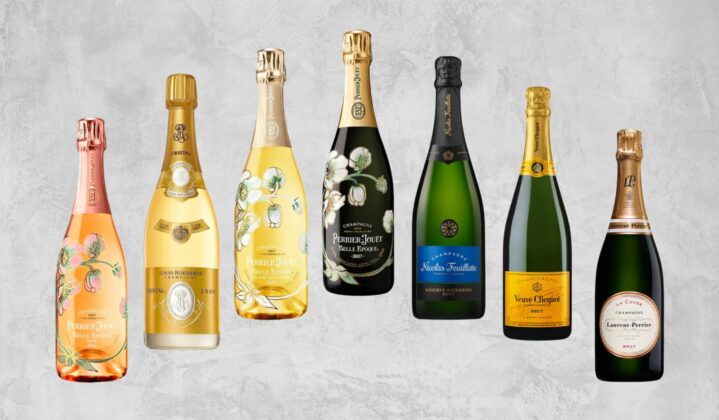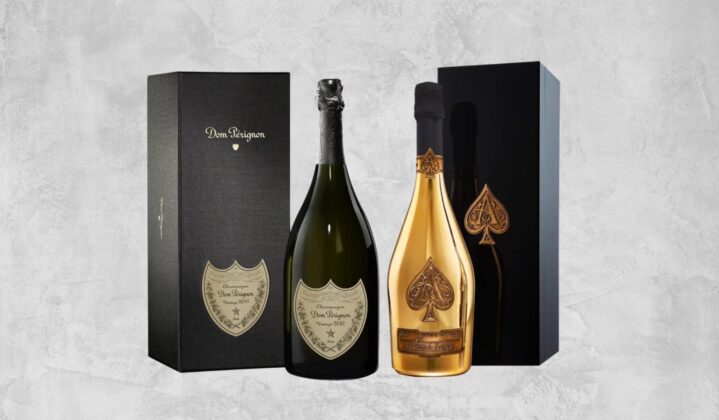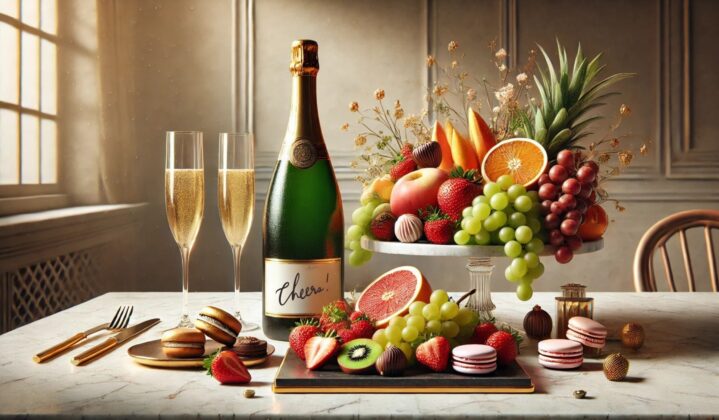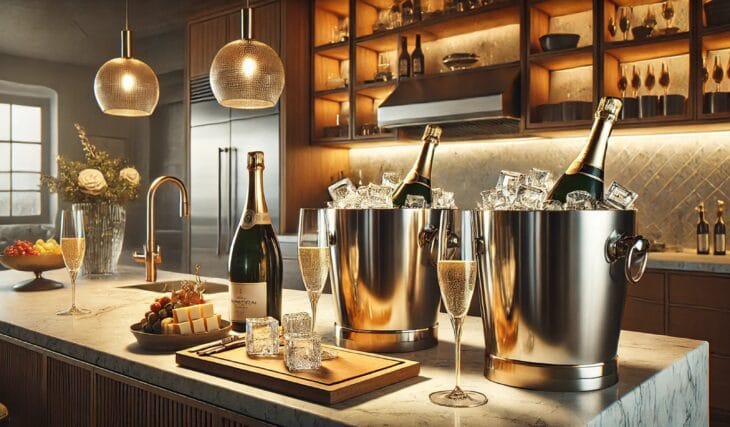What is the Difference Between Sparkling Wine and Champagne?
There’s something undeniably magical about the first sip of a sparkling wine—those delicate bubbles dancing on the palate, the crisp burst of flavor, and the unmistakable sense of celebration it brings. But as you pour yourself a glass, you might find yourself wondering: is this Champagne, or just another sparkling wine? Does it even matter?
For Champagne lovers, understanding the difference between sparkling wine and Champagne isn’t just about knowing what’s in your glass; it’s about appreciating the artistry, history, and craftsmanship behind every bottle. The straightforward answer is that sparkling wine can only be called “Champagne” if it comes from the Champagne region of France, crafted according to strict rules. Simply put, while all Champagne is sparkling wine, not every sparkling wine qualifies as Champagne.
Explore what sets Champagne apart while celebrating the rich diversity of bubbly from around the world.
Sparkling Wine vs Champagne
Let’s start with the basics: Champagne is a sparkling wine, but the reverse isn’t true. The distinction lies in the details.
What Makes Champagne Unique?

- Champagne comes exclusively from the Champagne region of France, located about 90 miles northeast of Paris. This small area boasts a unique climate and chalky soil that give its wines their distinct character.
- French law strictly regulates the production of Champagne, from the grape varieties used (Chardonnay, Pinot Noir, and Pinot Meunier) to the traditional method of production, known as Méthode Champenoise.
Sparkling Wines from Around the World
- Sparkling wines are produced globally, using a variety of methods, grapes, and styles. Each country brings its own flair to sparkling wine, making this category as diverse as it is delightful.
- Popular types include Prosecco from Italy, Cava from Spain, and Crémant from other French regions. Each has its own personality, influenced by regional grapes and winemaking traditions.
How Do I Know If I’m Drinking Champagne?

For the untrained eye, sparkling wine labels can be confusing. Here are some simple ways to identify genuine Champagne:
- Look for the word “Champagne”: Authentic Champagne must state its origin on the label.
- Check the producer’s name: Renowned Champagne houses like Dom Pérignon or Taittinger signify the real deal.
- Region matters: Only wines from the Champagne region of France can legally use the name.
- Production details: Labels may mention terms like “Méthode Champenoise” or “Traditional Method,” which are hallmarks of Champagne’s artisanal process.
If a sparkling wine is labeled as Prosecco, Cava, or anything else, it’s not Champagne—but that doesn’t make it any less enjoyable.
Is Sparkling Wine the Same as Champagne?
The short answer is no. While all Champagnes are sparkling wines, not all sparkling wines can claim the prestige of being Champagne. Here’s why:
- Geography: Champagne is exclusively from a specific region in France. Sparkling wines can come from anywhere.
- Production Method: Champagne is made using the Méthode Champenoise, a time-intensive process that requires secondary fermentation in the bottle. Sparkling wines, like Prosecco, often use the quicker and more affordable tank method.
- Flavor Profile: Champagne tends to have a more complex and refined flavor, with notes of brioche, almond, and citrus, thanks to its aging process.
This distinction doesn’t mean sparkling wines are inferior—they simply offer a broader spectrum of flavors and styles to explore.
Types of Sparkling Wine & Champagne
Popular Types of Sparkling Wine
Sparkling wine is a versatile and exciting category that offers wine lovers an array of choices. Here are some of the most popular types:
- Prosecco (Italy):
Light, fruity, and floral, Prosecco is made primarily from Glera grapes using the tank method. It has a refreshing, approachable style, making it perfect for casual celebrations or as a base for cocktails like Bellinis or Aperol Spritz.
- Cava (Spain):
Crafted using the traditional method, Cava delivers a crisp, citrusy profile with hints of nuttiness. Its affordability and complexity make it a popular alternative to Champagne for those seeking value without compromising on quality.
- Crémant (France):
Sparkling wines made in France but outside the Champagne region. Crémant is produced using the traditional method and can vary depending on the region, such as Crémant de Loire (Chenin Blanc-focused) or Crémant d’Alsace (Pinot Gris and Riesling blends).
- Franciacorta (Italy):
Known as Italy’s answer to Champagne, Franciacorta is a premium sparkling wine made with the traditional method. Using Chardonnay, Pinot Noir, and Pinot Bianco, it offers elegance and complexity that rival its French counterpart.
- Asti Spumante (Italy):
Made from Moscato Bianco grapes in the Piedmont region, this sparkling wine is sweet, floral, and low in alcohol. It’s ideal for pairing with desserts or for those who prefer a gentler bubbly experience.
- Sekt (Germany):
Germany’s sparkling wine, which ranges from dry to sweet. Sekt is typically light-bodied with fresh apple and floral notes. High-quality Sekt, known as Winzersekt, is made from single varietals like Riesling using traditional methods.
- Lambrusco (Italy):
A sparkling red wine made in Italy’s Emilia-Romagna region. Lambrusco ranges from dry to sweet and pairs well with cured meats, making it a favorite for hearty meals.
- Sparkling Shiraz (Australia):
A uniquely Australian offering, this sparkling red wine is rich, bold, and often slightly sweet. It’s a festive option for holiday dinners and barbecues.
Champagne Varieties
While sparkling wine spans the globe, Champagne offers its own distinct styles, each highlighting its region’s terroir and traditional winemaking techniques:
- Blanc de Blancs:
Made exclusively from Chardonnay grapes, Blanc de Blancs is known for its crisp acidity, delicate floral aromas, and citrus-forward profile. It’s a favorite for seafood pairings.
- Blanc de Noirs:
Crafted entirely from black grape varieties like Pinot Noir or Pinot Meunier, Blanc de Noirs has a richer, fuller body with flavors of red berries and brioche.
- Rosé Champagne:
Pink and elegant, Rosé Champagne can be made by blending red and white wines or through extended skin contact during fermentation. Its fruity and floral notes make it versatile for both celebrations and intimate dinners.
- Prestige Cuvée:
These are the top-tier offerings from Champagne houses, showcasing the highest quality grapes and extended aging. Examples include Dom Pérignon and Cristal.
Sweetness Levels of Sparkling Wine & Champagne

The sweetness of sparkling wines and Champagnes is determined by the dosage, or the addition of sugar, after disgorgement. Here’s a breakdown:
- Brut Nature: Bone-dry with no added sugar, offering pure and crisp flavors.
- Extra Brut: Slightly more approachable than Brut Nature but still very dry.
- Brut: The most popular style, dry with subtle sweetness that balances acidity.
- Extra Dry: A touch sweeter than Brut, ideal for those who prefer softer bubbles.
- Demi-Sec: Sweet and dessert-friendly, often served with pastries or fresh fruit.
- Doux: Extremely sweet, typically reserved for indulgent dessert wines.
How to Serve Champagne & Sparkling Wines
Serving sparkling wine correctly enhances its aromas, flavors, and presentation:
- Temperature: Chill to 45–50°F (7–10°C) for optimal freshness.
- Glassware: Use tulip-shaped glasses or Champagne flutes to preserve bubbles and concentrate aromas.
- Opening Tips: Hold the bottle at a 45° angle, loosen the cage while holding the cork firmly, and twist the bottle—not the cork—to gently release the pressure without losing the effervescence.
Pairing Champagne with Food
Sparkling wines and Champagnes are incredibly food-friendly due to their acidity and bubbles. Here are some pairing suggestions:
- Brut Champagne:
Pairs beautifully with oysters, sushi, fried chicken, or truffle fries for an indulgent treat.
- Rosé Champagne:
Complements grilled salmon, roasted duck, or chocolate-dipped strawberries.
- Demi-Sec or Sweet Sparkling Wines:
Ideal with fruit tarts, panna cotta, or spicy dishes like Thai curry.
- Prosecco:
Enjoy with antipasti, light salads, or prosciutto-wrapped melon.
Champagne and Sparkling Wine Grapes
The choice of grapes plays a pivotal role in defining the style, flavor, and character of Champagne and sparkling wines. While Champagne relies on a select few grape varieties, sparkling wines from around the world showcase a broader palette.
Champagne Grapes:
Chardonnay:
The only white grape used in Champagne production, Chardonnay is prized for its elegance, vibrant acidity, and citrusy freshness. It offers flavors of green apple, lemon zest, and white flowers, with a mineral backbone. Chardonnay adds finesse and aging potential to blends and is the sole grape in Blanc de Blancs Champagnes, creating crisp, delicate wines.
Pinot Noir:
One of the primary black grapes in Champagne, Pinot Noir contributes structure, depth, and boldness. Its flavors range from red fruits like cherries and raspberries to earthy and spicy notes. This grape enhances body and richness, making it essential in Blanc de Noirs and complex blends.
Pinot Meunier:
Often considered the third grape of Champagne, Pinot Meunier is fruit-forward, soft, and approachable. It delivers flavors of ripe apple, apricot, and subtle floral notes. Pinot Meunier adds roundness and aromatic complexity, particularly in younger Champagnes.
Sparkling Wine Grapes
Glera:
The signature grape of Prosecco, Glera hails from Italy’s Veneto region. Known for its light, floral, and fruity profile, it showcases flavors of pear, green apple, and white flowers with a touch of honey. Glera’s fresh and aromatic qualities make it ideal for the tank method of sparkling wine production.
Macabeo, Xarel·lo, Parellada:
These three grapes form the foundation of Spain’s Cava. Macabeo adds floral and herbal aromas with a fresh, light structure, Xarel·lo contributes body, acidity, and citrus notes, and Parellada enhances the blend with delicate apple and pear flavors. Together, they create a balanced, complex, and refreshing sparkling wine.
Chenin Blanc:
Predominantly grown in France’s Loire Valley and South Africa, Chenin Blanc is celebrated for its high acidity and honeyed, fruity character. It offers flavors of green apple, quince, and honey, with hints of minerality. Its versatility and natural acidity make it a cornerstone for Crémant and South African Cap Classique sparkling wines.
Moscato Bianco:
Found in Italy’s Piedmont region, Moscato Bianco is the aromatic grape behind Asti Spumante. Its sweet and floral profile includes flavors of ripe peach, orange blossom, and tropical fruits. This grape’s natural sweetness and low alcohol content make it a popular choice for dessert sparkling wines.
Riesling:
A key grape in Germany’s Sekt, Riesling is valued for its crisp acidity and vibrant aromatics. It brings flavors of green apple, citrus, and floral notes to sparkling wines. Riesling-based sparkling wines are often light, refreshing, and elegant, showcasing the grape’s signature complexity.
How Sparkling Wine and Champagne Are Made
Traditional Method (Méthode Champenoise):
This labor-intensive process, used for Champagne and premium sparkling wines like Cava and Franciacorta, involves a second fermentation in the bottle. After primary fermentation, base wines are blended, yeast and sugar are added, and the wine is sealed in the bottle to create bubbles. The wine then ages on its lees for months or even years to develop complexity. Riddling (rotating the bottles) collects sediment, which is eventually removed through disgorging, before a final sugar adjustment (dosage) is made.
Tank Method (Charmat):
Most commonly used for Prosecco, this method involves fermenting the wine in large stainless steel tanks rather than in individual bottles. This process is faster and more cost-effective, retaining the wine’s fresh and fruity characteristics. Once fermentation is complete, the wine is filtered, bottled, and sealed under pressure.
Carbonation:
The simplest and least expensive method, carbonation involves injecting CO2 directly into still wine to create bubbles. While this method lacks the complexity of the other processes, it is often used for entry-level sparkling wines intended for casual consumption.
Champagne vs Sparkling Wine Pricing
Pricing is one of the most significant factors distinguishing Champagne from sparkling wine. While both categories offer options for a range of budgets, the differences in production methods, origin, and branding heavily influence their costs.
Champagne Pricing
- Luxury Appeal:
Champagne is synonymous with prestige and exclusivity, often regarded as the pinnacle of sparkling wine. This perception of luxury significantly impacts its pricing.
- Starting Prices:
Most entry-level Champagne bottles start at around $40–$60, offering a taste of this renowned sparkling wine while maintaining its high-quality standards.
- Premium Range:
For vintage or Prestige Cuvée Champagnes, such as Dom Pérignon, Krug, or Cristal, prices can exceed $300 and, in rare cases, soar into the thousands, particularly for limited releases or aged bottles.
- Factors Driving Costs:
Region-Specific Production:
Champagne is only produced in a limited area, driving up demand and limiting supply.
Traditional Method:
The labor-intensive Méthode Champenoise, with its prolonged aging and meticulous handling, adds to production costs.
Aging Requirements:
Non-vintage Champagnes must be aged for at least 15 months, while vintage bottles often age for years, increasing production time and cost.
Sparkling Wine Pricing
- Accessibility: Sparkling wines are generally more affordable, with many high-quality options available for budget-conscious buyers.
- Prosecco: Prices for this light and fruity sparkling wine start as low as $10–$15 for basic offerings, with higher-end bottles, such as those labeled Prosecco Superiore DOCG, costing around $20–$30.
- Cava: Another affordable alternative, with most bottles priced between $10–$25. Premium Cavas, particularly Gran Reservas, can reach $40–$60, showcasing complexity similar to Champagne.
- Franciacorta: This Italian sparkling wine, made using the traditional method, occupies a higher price point than Prosecco or Cava. Prices typically range from $25–$75, with top-tier offerings rivaling Champagne in cost and quality.
- Sekt: German sparkling wine offers an accessible price range starting around $15, with higher-quality Winzersekt priced between $30–$50.
Why the Price Difference?
1. Production Method:
Sparkling wines like Prosecco are made using the tank method, which is quicker and less expensive than the traditional method used for Champagne. This efficiency reduces production costs and consumer prices.
Premium sparkling wines such as Franciacorta and some Cavas use the traditional method, resulting in prices closer to Champagne.
2. Aging Requirements:
Champagne undergoes extended aging, contributing to its complexity and higher costs. Many sparkling wines, such as Prosecco, have minimal aging, keeping prices lower.
3. Terroir and Origin:
Champagne is produced in a geographically limited region with a high demand for its products. Other sparkling wines, like Cava and Prosecco, come from larger regions with more production capacity, making them more affordable.
4. Brand Value:
Champagne’s long-standing association with luxury, celebration, and exclusivity elevates its price. Marketing and branding play a significant role in maintaining its premium image.
While Champagne commands the spotlight for its luxury and prestige, sparkling wines like Prosecco, Cava, and Franciacorta offer excellent value and diverse styles to explore. For casual gatherings or everyday indulgence, sparkling wine provides a wide range of affordable options. For special occasions, Champagne delivers unmatched elegance and refinement, often justifying its higher price tag. Whether you choose an accessible Prosecco or a world-renowned Champagne, there’s a bubbly for every budget and celebration.
A Toast to All Bubbles
Whether it’s the elegance of Champagne or the vibrant charm of Prosecco, sparkling wines offer something for every palate and occasion. Each sip invites celebration, bringing people together to toast life’s greatest moments. So, wine lovers, raise your glass to the beauty of bubbles and savor the journey they take you on. Cheers!
FAQs:
Can I saber sparkling wine?
Yes, you can saber sparkling wine, but it works best with bottles made using the traditional method (e.g., Champagne, Cava, or Franciacorta) due to the higher internal pressure that ensures a clean break. Prosecco and other sparkling wines made with the tank method might have lower pressure, making sabering less effective.
Why can’t you call sparkling wine Champagne?
The term “Champagne” is protected by strict regulations and can only be used for sparkling wine produced in the Champagne region of France. These regulations ensure that the name reflects the region’s unique terroir, traditional production methods, and historical significance.
Why is Champagne more expensive than sparkling wine?
Champagne’s higher price is due to its limited production region, labor-intensive traditional method, longer aging requirements, and association with luxury and exclusivity. Sparkling wines like Prosecco or Cava are more affordable due to larger production areas and faster, more cost-efficient methods like the tank method.
How long can you store Champagne or sparkling wine?
- Non-Vintage Champagne: Typically best consumed within 3–4 years of purchase.
- Vintage Champagne: Can be stored for 10–15 years or more, depending on the producer.
- Sparkling Wines: Most are meant for immediate enjoyment and should be consumed within 1–2 years of purchase, except for high-quality options like Franciacorta, which can age longer.
Does sparkling wine age like Champagne?
Most sparkling wines do not age like Champagne due to differences in production methods and grape varieties. Champagne undergoes extended aging on its lees, developing complexity and depth over time. Sparkling wines like Prosecco or Cava are typically designed for freshness and should be enjoyed young.
Why does Champagne have smaller, more refined bubbles than other sparkling wines?
Champagne’s smaller, more refined bubbles result from the traditional method of production. During secondary fermentation in the bottle, CO2 is naturally dissolved into the wine, creating tiny, persistent bubbles. Sparkling wines made using the tank method or carbonation tend to have larger, less consistent bubbles.
What is the difference between vintage and non-vintage Champagne and sparkling wine?
- Vintage Champagne: Made exclusively from grapes harvested in a single exceptional year. It is often aged longer and offers complex, nuanced flavors.
- Non-Vintage Champagne: A blend of wines from multiple years, ensuring consistency in flavor and quality.
- Vintage Sparkling Wine: Similar to vintage Champagne but less common.
- Non-Vintage Sparkling Wine: The majority of sparkling wines are non-vintage, designed for freshness and immediate enjoyment.
How can you identify a high-quality sparkling wine and Champagne?
- Label Clues: Look for terms like “Méthode Champenoise” or “Traditional Method.”
- Region: Champagne, Franciacorta, and high-end Cava indicate quality regions.
- Appearance: Small, persistent bubbles signify quality.
- Aromas and Flavors: Complex notes of toast, brioche, or citrus suggest high-quality aging.
- Producer Reputation: Established brands or renowned producers are reliable indicators.
What’s the best way to store opened Champagne or sparkling wine?
To preserve bubbles and freshness:
- Use a Champagne stopper to seal the bottle.
- Store in the refrigerator at a consistent temperature of 45–50°F (7–10°C).
- Consume within 1–3 days for optimal taste.
Are there health benefits to drinking Champagne or sparkling wine?
In moderation, Champagne and sparkling wine may offer health benefits, including:
- Antioxidants: Polyphenols may help improve heart health by reducing inflammation and promoting good circulation.
- Fewer Calories: Dry styles like Brut Champagne are lower in calories than many other alcoholic beverages.
- Mood Enhancement: The celebratory nature of bubbles can boost mood and create a sense of joy.
However, excessive consumption negates any potential benefits, so enjoy responsibly!
